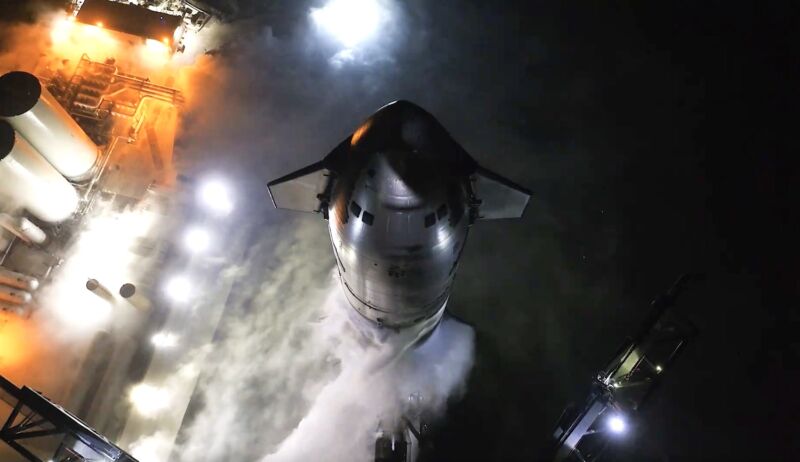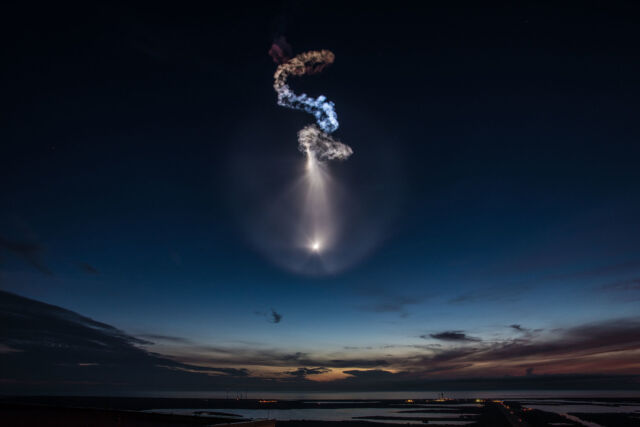The launch window opens before sunrise Thursday at SpaceX’s launch site in Texas.

The Federal Aviation Administration said Wednesday it has approved a commercial launch license for the third full-scale test flight of SpaceX’s giant Starship rocket.
This is the final regulatory hurdle before SpaceX can launch Starship from South Texas. The third flight of the world’s most powerful rocket, following a pair of test launches last year, is scheduled for Thursday morning.
SpaceX’s Starship rocket and Super Heavy booster will take off from the Starbase test site on the Texas Gulf Coast, a few miles north of the US-Mexico border. The launch window for the nearly 400-foot-tall (121-meter) rocket opens at 7 am CDT (12:00 UTC) Thursday and extends for 110 minutes. You can watch the launch live on SpaceX’s X page or on one of several third-party YouTube livestreams. We have embedded a livestream from LabPadre and Spaceflight Now here.
“The FAA determined SpaceX met all safety, environmental, policy and financial responsibility requirements,” the regulatory agency said in a statement.
“The license applies to all phases of the proposed OFT-3 (Orbital Flight Test-3) operation,” the FAA said. “This includes preflight preparations and liftoff from Texas, the water landing of the Super Heavy booster in the Gulf of Mexico, and the water landing of the Starship vehicle in the Indian Ocean.”
This is the first time SpaceX will target the Indian Ocean for splashdown of Starship. The two test flights last year were supposed to culminate in a splashdown in the Pacific Ocean, but SpaceX has altered the trajectory for this launch in order to accomplish a few additional test objectives, including the restart of a Raptor engine in space for the first time.
The FAA performed a “tiered environmental assessment” to study the environmental effects of a Starship reentry and water landing in the Indian Ocean. Federal officials signed off on SpaceX’s proposal.
Green board
If Starship gets off the ground at the opening of Thursday’s launch window, it would lift off nearly 40 minutes before sunrise at Starbase. This would be the first night launch of Starship, but the timing of liftoff could be close enough to sunrise to allow sunlight to illuminate the rocket’s expanding engine plumes as it climbs into the upper atmosphere.Advertisement
Twilight launches are spectacular and often produce a so-called “jellyfish” effect as sunlight reflects off ice crystals in a rocket’s exhaust trail. This colorful phenomenon is visually striking against a dark sky before sunrise or after sunset. Of course, the visibility of a rocket’s jellyfish exhaust trail depends on cloud cover, but assuming clear skies, a Starship launch at the opening of the launch window Thursday could be visible from as far away as Houston and other parts of the Gulf Coast.
The weather outlook for Thursday at Starbase looks generally favorable in terms of cloud cover; there are no thunderstorms in the official National Weather Service forecast. However, forecasters predict breezy conditions overnight Wednesday into Thursday, with gusty winds of 20 to 30 mph. SpaceX hasn’t said what the wind limit is for a Starship launch. There is also a chance of patchy fog overnight into Thursday morning, but this is not expected to be a factor in the launch other than for viewing conditions.

The results from the first Starship test flight last April were mixed. The blast from the rocket’s Raptor engines damaged the launch pad, and several of the booster’s engines failed before the vehicle tumbled out of control and self-destructed a few minutes after liftoff.
SpaceX upgraded the pad with a water deluge system to protect the ground infrastructure at Starbase from the blast and heat generated by the Super Heavy booster’s 33 Raptor engines. Engineers also made improvements in engine reliability and changed the way Starship’s upper stage separates from its Super Heavy booster a few minutes into the flight. SpaceX also introduced a new “hot staging” technique, which involves igniting the upper stage’s six Raptor engines a fraction of a second before stage separation.
All these changes worked like a charm on the second Starship launch in November, and the Starship upper stage nearly reached its target velocity. During a planned vent of excess liquid oxygen, Starship developed a leak that resulted in a “combustion event,” ultimately causing the rocket’s computer to issue a self-destruct command.
The Super Heavy booster was supposed to attempt a controlled splashdown in the Gulf of Mexico in a test of SpaceX’s plans to recover and reuse the massive Starship first stage. The booster also self-destructed in the upper atmosphere after some of its engines, which were supposed to guide it back toward an offshore splashdown zone, lost pressure in their oxidizer turbopumps. SpaceX traced the cause of this problem to filter blockage in the liquid oxygen supply.
Changes for Flight 3
Despite these technical issues, Starship reached space for the first time on the November test flight. SpaceX wants to build on this progress with the launch this week. In a sign of officials’ optimism, SpaceX added a few additional objectives for the third Starship launch.
One change for Starship’s third flight is in the prelaunch propellant loading sequence. The launch team will begin filling the two-stage rocket with more than 10 million pounds of super-cold methane and liquid oxygen around 53 minutes before liftoff. Previously, SpaceX started propellant loading more than an hour-and-a-half before launch. Starship should be fully loaded around three minutes prior to launch, and its 33 Raptor engines will roar to life at T-minus three seconds.
Following a similar profile as the November launch, the Super Heavy booster will head east from Starbase and burn its methane-fueled engines for about 2 minutes and 42 seconds, then detach as Starship ignites its six engines. While Super Heavy maneuvers toward a targeted splashdown in the Gulf of Mexico, Starship will fire its six engines until T+plus 8 minutes and 33 seconds, gaining enough velocity to travel on a suborbital trajectory carrying it halfway around the world to the Indian Ocean.
This is different from Starship’s last launch, which would have seen the vehicle splash down in the Pacific Ocean northwest of Hawaii. However, because it self-destructed late in its burn, debris from Starship fell into the Atlantic Ocean north of Puerto Rico.
Starship’s third test flight will include an early-stage demonstration of SpaceX’s in-space refueling technology. Before Starship can fly to the Moon for NASA’s Artemis program or anywhere else beyond low-Earth orbit, SpaceX needs to master refueling in orbit. This will involve an intricate choreography of Starship tankers flying into low-Earth orbit to deliver fresh supplies of methane and liquid oxygen propellants to a Starship rocket bound for deep space.Advertisement
On this flight, SpaceX will try transferring cryogenic propellant between a main tank and a header tank at the top of Starship.
SpaceX also wants to demonstrate opening and closing Starship’s payload bay door, a prerequisite for future flights, possibly as soon as this year, that could deploy next-generation satellites for the Starlink Internet network.
Finally, SpaceX will attempt to restart a Raptor engine on Starship in space. If successful, this would be another Starship milestone. Raptors will have to reignite in space for most of the missions SpaceX wants Starship to perform, including human flights to the Moon, where the engines will control the spacecraft’s descent to the lunar surface and then launch it back into orbit.
Starship will fall back into the atmosphere over the Indian Ocean. If SpaceX is successful in demonstrating the launch segment of Starship’s flight profile, the return to Earth will be the first time engineers get a chance to assess the performance of the vehicle’s heat shield, made up of hexagonal ceramic tiles covering sections of the ship that will see the highest temperatures during reentry. Like the Super Heavy booster, Starship itself is designed to be recoverable and reusable.
According to the FAA, for this test flight, Starship will descend passively through the atmosphere. SpaceX will not attempt to recover the vehicle.
“If Starship completes the descent phases as nominally planned, SpaceX expects Starship would explode and break up upon impact with the Indian Ocean’s surface, where most debris would be expected to sink,” FAA officials wrote in their updated environmental assessment. “Any vehicle breakups prior to Starship intact impact would be considered an anomaly.”
Despite two Starship flights already in the books, SpaceX hasn’t had an opportunity to put the vehicle through the trials of reentry. Getting to this point with Starship’s third test flight would allow engineers to check many boxes regarding the rocket’s launch sequence and open an entirely new phase of learning about the vehicle’s ability to come back to Earth.




